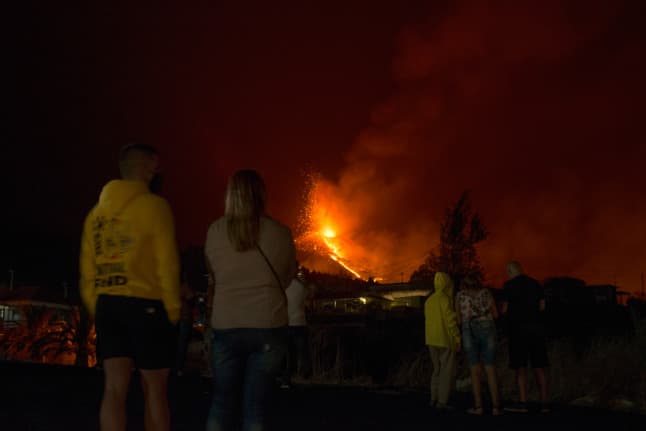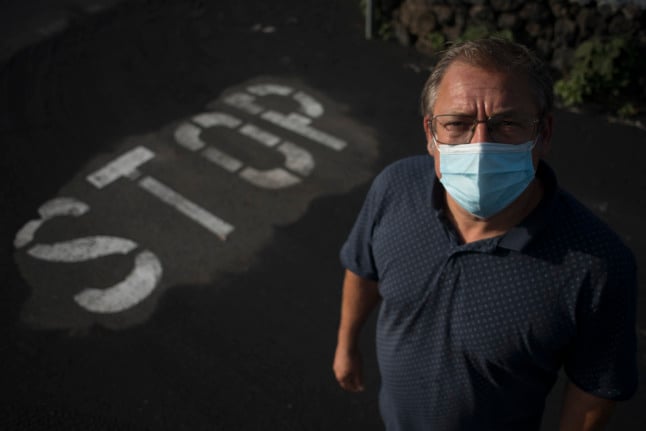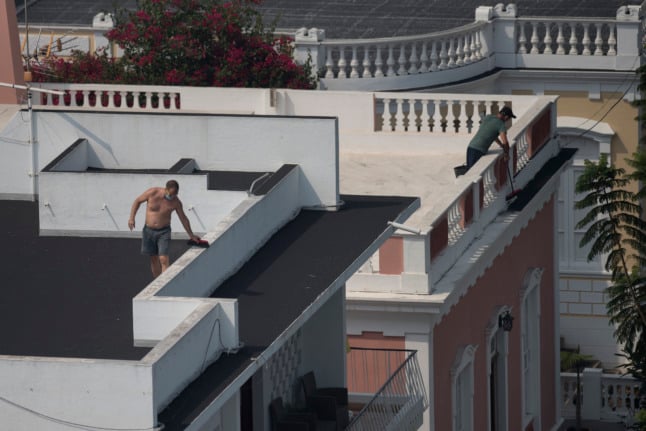'This is my land': Canary volcano zone residents flee danger but want to stay on

Just a few weeks ago, Ruediger Wastel was living an idyllic life with his wife and their baby boy in the Spanish Canary island of La Palma.
Everything changed when the island's Cumbre Vieja volcano began erupting on September 19th.
Wastel, 52, shares photos of what was once his home -- with AFP.
His home, one of the first to be engulfed by the volcano's incandescent lava, was about 300 metres from where the mountain exploded.

Ruediger Wastel, a victim who lost his house to the eruption of the Cumbre Vieja volcano, poses for pictures in El Paso, on the Canary Island of La Palma in October 2nd, 2021. (Photo by JORGE GUERRERO / AFP)
"I was working in the restaurant when I heard the explosion," the German owner said.
His restaurant, the Franchipani, is located in El Paso, a town in the west of the island where lava is smothering communities.
"It took me 10 minutes to find my love, who was in the car crying and scared," he said of his wife, who had rushed to their home -- about 300 metres from the lava flow -- to gather a few belongings.
"A member of the local council told me a fortnight ago: 'You have to make up your mind, you can't live here any more,'" he says.
But Wastel has no plans to leave the small island that he has called home for 16 years.
"This is my land. My son was born here, I met my love here," he says. "The best part of our lives is here, even if some of it is under the lava."

Residents clean ash covering a building roof with brooms, following the Cumbre Vieja volcano eruption, in Los Llanos de Aridane, in the Canary Island of La Palma on October 3rd, 2021. (Photo by JORGE GUERRERO / AFP)
'Very hard months' ahead
This part of the island already suffered forest fires in August that led to the evacuation of hundreds of people and destroyed homes.
The Cumbre Vieja volcano has left at least 946 buildings of all types completely destroyed and prompted the evacuation of around 6,000 people.
READ ALSO: La Palma volcano eruptions continue as number of destroyed houses rises to 946
Abel Armas, 64, told AFP: "Everything I had is gone and I have been crying a lot."
Stopped at a petrol station with his truckload of bananas, one of the island's two main economic resources along with tourism, he said the lava had buried 40 years of his life.
But he has no intention of leaving.
Like other residents, Armas notes that the three eruptions since 1949 have caused a total of only three deaths -- two of them from toxic gas inhalation -- and that the current eruption, which has caused no deaths or injuries, is by far the least devastating.
In dozens of places elsewhere in the world the risks are "much, much greater, not just for homes, but for people", argues Manuel Perera, an architect and urban planning adviser.
His colleague Elena Pais is in charge of helping victims sheltering at the Severo Rodriguez sports complex in Los Llanos.
Piles of clothes are neatly arranged by gender, age and size, as well as food, kitchen utensils, blankets, sheets, toys and school supplies.
Pais, who has had little rest in the past two weeks, says the worst is yet to come.
"We are going to have very hard months," she told AFP. "There are some who are resisting better, but... what we are going through is terrible," she said.
Social workers, psychologists and volunteers, many of them teenagers, guide people who need assistance.
Many of those who walk through the door of the sports complex feel "ashamed" to have to ask for help, says Victor Simon, a 48-year-old volunteer.
Comments
See Also
Everything changed when the island's Cumbre Vieja volcano began erupting on September 19th.
Wastel, 52, shares photos of what was once his home -- with AFP.
His home, one of the first to be engulfed by the volcano's incandescent lava, was about 300 metres from where the mountain exploded.

"I was working in the restaurant when I heard the explosion," the German owner said.
His restaurant, the Franchipani, is located in El Paso, a town in the west of the island where lava is smothering communities.
"It took me 10 minutes to find my love, who was in the car crying and scared," he said of his wife, who had rushed to their home -- about 300 metres from the lava flow -- to gather a few belongings.
"A member of the local council told me a fortnight ago: 'You have to make up your mind, you can't live here any more,'" he says.
But Wastel has no plans to leave the small island that he has called home for 16 years.
"This is my land. My son was born here, I met my love here," he says. "The best part of our lives is here, even if some of it is under the lava."

'Very hard months' ahead
This part of the island already suffered forest fires in August that led to the evacuation of hundreds of people and destroyed homes.
The Cumbre Vieja volcano has left at least 946 buildings of all types completely destroyed and prompted the evacuation of around 6,000 people.
READ ALSO: La Palma volcano eruptions continue as number of destroyed houses rises to 946
Abel Armas, 64, told AFP: "Everything I had is gone and I have been crying a lot."
Stopped at a petrol station with his truckload of bananas, one of the island's two main economic resources along with tourism, he said the lava had buried 40 years of his life.
But he has no intention of leaving.
Like other residents, Armas notes that the three eruptions since 1949 have caused a total of only three deaths -- two of them from toxic gas inhalation -- and that the current eruption, which has caused no deaths or injuries, is by far the least devastating.
In dozens of places elsewhere in the world the risks are "much, much greater, not just for homes, but for people", argues Manuel Perera, an architect and urban planning adviser.
His colleague Elena Pais is in charge of helping victims sheltering at the Severo Rodriguez sports complex in Los Llanos.
Piles of clothes are neatly arranged by gender, age and size, as well as food, kitchen utensils, blankets, sheets, toys and school supplies.
Pais, who has had little rest in the past two weeks, says the worst is yet to come.
"We are going to have very hard months," she told AFP. "There are some who are resisting better, but... what we are going through is terrible," she said.
Social workers, psychologists and volunteers, many of them teenagers, guide people who need assistance.
Many of those who walk through the door of the sports complex feel "ashamed" to have to ask for help, says Victor Simon, a 48-year-old volunteer.
Join the conversation in our comments section below. Share your own views and experience and if you have a question or suggestion for our journalists then email us at [email protected].
Please keep comments civil, constructive and on topic – and make sure to read our terms of use before getting involved.
Please log in here to leave a comment.